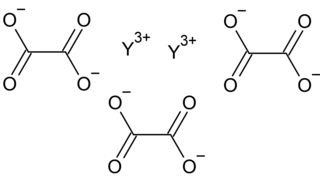Related Research Articles
A borate is any of a range of boron oxyanions, anions containing boron and oxygen, such as orthoborate BO3−3, metaborate BO−2, or tetraborate B4O2−7; or any salt of such anions, such as sodium metaborate, Na+[BO2]− and borax (Na+)2[B4O7]2−. The name also refers to esters of such anions, such as trimethyl borate B(OCH3)3 but they are alkoxides.
Sodium borate is a generic name for any salt of sodium with an anion consisting of boron and oxygen, and possibly hydrogen, or any hydrate thereof. It can be seen as a hydrated sodium salt of the appropriate boroxy acid, although the latter may not be a stable compound.

Organoboron chemistry or organoborane chemistry studies organoboron compounds, also called organoboranes. These chemical compounds combine boron and carbon; typically, they are organic derivatives of borane (BH3), as in the trialkyl boranes.
Lithium metaborate is a chemical compound of lithium, boron, and oxygen with elemental formula LiBO2. It is often encountered as a hydrate, LiBO2·nH2O, where n is usually 2 or 4. However, these formulas do not describe the actual structure of the solids.

Acetylenedicarboxylic acid or butynedioic acid is an organic compound with the formula H2C4O4 or HO−C(=O)−C≡C−C(=O)−OH. It is a crystalline solid that is soluble in diethyl ether.

Hydrogenoxalate or hydrogen oxalate(IUPAC name: 2-Hydroxy-2-oxoacetate) is an anion with chemical formula HC2O−4 or HO−C(=O)−CO−2, derived from oxalic acid by the loss of a single proton; or, alternatively, from the oxalate anion C2O2−4 by addition of a proton. The name is also used for any salt containing this anion. Especially in older literature, hydrogenoxalates may also be referred to as bioxalates, acid oxalates, or monobasic oxalates. Hydrogenoxalate is amphoteric, in that it can react both as an acid or a base.

Lithium tetrakis(pentafluorophenyl)borate is the lithium salt of the weakly coordinating anion (B(C6F5)4)−. Because of its weakly coordinating abilities, lithium tetrakis(pentafluorophenyl)borate makes it commercially valuable in the salt form in the catalyst composition for olefin polymerization reactions and in electrochemistry. It is a water-soluble compound. Its anion is closely related to the non-coordinating anion known as BARF. The tetrakis(pentafluorophenyl)borates have the advantage of operating on a one-to-one stoichiometric basis with Group IV transition metal polyolefin catalysts, unlike methylaluminoxane (MAO) which may be used in large excess.
Organoxenon chemistry is the study of the properties of organoxenon compounds, which contain carbon to xenon chemical bonds. The first organoxenon compounds were divalent, such as (C6F5)2Xe. The first tetravalent organoxenon compound, [C6F5XeF2][BF4], was synthesized in 2004. So far, more than one hundred organoxenon compounds have been researched.

A metaborate is a borate anion consisting of boron and oxygen, with empirical formula BO−2. Metaborate also refers to any salt or ester of such anion. Metaborate is one of the boron's oxyanions. Metaborates can be monomeric, oligomeric or polymeric.

Monofluorophosphate is an anion with the formula PO3F2−, which is a phosphate group with one oxygen atom substituted with a fluoride atom. The charge of the ion is −2. The ion resembles sulfate in size, shape and charge, and can thus form compounds with the same structure as sulfates. These include Tutton's salts and langbeinites. The most well-known compound of monofluorophosphate is sodium monofluorophosphate, commonly used in toothpaste.

Difluorophosphate or difluorodioxophosphate or phosphorodifluoridate is an anion with formula PO2F−2. It has a single negative charge and resembles perchlorate and monofluorosulfonate in shape and compounds. These ions are isoelectronic, along with tetrafluoroaluminate, phosphate, orthosilicate, and sulfate. It forms a series of compounds. The ion is toxic to mammals as it causes blockage to iodine uptake in the thyroid. However it is degraded in the body over several hours.

Caesium oxalate, or dicesium oxalate, or cesium oxalate is a chemical compound with the chemical formula Cs2C2O4. It is a caesium salt of oxalic acid. It consists of caesium cations Cs+ and oxalate anions C2O2−4.
The borate fluorides or fluoroborates are compounds containing borate or complex borate ions along with fluoride ions that form salts with cations such as metals. They are in the broader category of mixed anion compounds. They are not to be confused with tetrafluoroborates (BF4) or the fluorooxoborates which have fluorine bonded to boron.

Transition metal oxalate complexes are coordination complexes with oxalate (C2O42−) ligands. Some are useful commercially, but the topic has attracted regular scholarly scrutiny. Oxalate (C2O42-) is a kind of dicarboxylate ligand. As a small, symmetrical dinegative ion, oxalate commonly forms five-membered MO2C2 chelate rings. Mixed ligand complexes are known, e.g., [Co(C2O4)(NH3)4]κ+.

Yttrium oxalate is an inorganic compound, a salt of yttrium and oxalic acid with the chemical formula Y2(C2O4)3. The compound does not dissolve in water and forms crystalline hydrates—colorless crystals.
The carbonate oxalates are mixed anion compounds that contain both carbonate (CO3) and oxalate (C2O4) anions. Most compounds incorporate large trivalent metal ions, such as the rare earth elements. Some carbonate oxalate compounds of variable composition are formed by heating oxalates.
Oxalate sulfates are mixed anion compounds containing oxalate and sulfate. They are mostly transparent, and any colour comes from the cations.
An oxalate chloride or oxalato chloride is a mixed anion compound contains both oxalate and chloride anions.
Lithium hexafluorotitanate is an inorganic compound of lithium, fluorine, and titanium with the chemical formula Li2TiF6.

Lithium bis(oxalate)borate is the inorganic compound with the formula LiB(C2O4)2. A white solid, it is used as an electrolyte in some lithium batteries. It is one of several borate oxalates.
References
- 1 2 3 4 5 6 7 8 9 Bessler, Eberhard; Weidlein, Johann (1 August 1982). "Borkomplexe mit Dicarbonsäuren: Bis(oxalato)borate und Bis(malonato)borate" [Boron Complexes with Dicarboxylic Acids: Bis(oxalato)borates and Bis(malonato)borates]. Zeitschrift für Naturforschung B. 37 (8): 1020–1025. doi: 10.1515/znb-1982-0813 . S2CID 53546940.
- 1 2 Zavalij, Peter Y.; Yang, Shoufeng; Whittingham, M. Stanley (2003-12-01). "Structures of potassium, sodium and lithium bis(oxalato)borate salts from powder diffraction data". Acta Crystallographica Section B. 59 (6): 753–759. doi:10.1107/S0108768103022602. ISSN 0108-7681. PMID 14634252.
- ↑ PubChem. "Lithium difluoro(oxalato)borate". pubchem.ncbi.nlm.nih.gov. Retrieved 2021-07-19.
- 1 2 Allen, Joshua L.; Han, Sang-Don; Boyle, Paul D.; Henderson, Wesley A. (November 2011). "Crystal structure and physical properties of lithium difluoro(oxalato)borate (LiDFOB or LiBF2Ox)". Journal of Power Sources. 196 (22): 9737–9742. Bibcode:2011JPS...196.9737A. doi:10.1016/j.jpowsour.2011.07.065.
- ↑ Globa, N. I.; Pushyk, O. B.; Gromadskyi, D. G.; Milovanova, O. I.; Kirillov, S. A. (June 2016). "Electrochemical behavior of activated carbon electrodes in electric double layer capacitors with tetrametylammonium bis(oxalato)borate electrolyte synthesized by microwave irradiation". Russian Journal of Applied Chemistry. 89 (6): 1000–1008. doi:10.1134/S1070427216060252. ISSN 1070-4272. S2CID 100297708.
- ↑ Wang, Liang; Zhang, Hong; Ge, Rile; Wang, Chaolei; Guo, Wei; Shi, Yantao; Gao, Yanan; Ma, Tingli (2013). "First application of bis(oxalate)borate ionic liquids (ILBOBs) in high-performance dye-sensitized solar cells". RSC Advances. 3 (31): 12975. Bibcode:2013RSCAd...312975W. doi:10.1039/c3ra41180j. ISSN 2046-2069.
- 1 2 3 4 5 6 7 8 Sprenger, Jan A.P.; Schäfer, Marius; Ignatiev, Nikolai; Finze, Maik (June 2015). "Salts of novel chelatoborate anions: [R F BX(ox)] − (R F = CF 3 , C 2 F 5 ; X = F, OMe; ox = oxalato) and [R F B(OMe)(cat)] − (R F = CF 3 , C 2 F 5 ; cat = catecholato)". Journal of Fluorine Chemistry. 174: 30–35. doi:10.1016/j.jfluchem.2014.08.003.
- ↑ Mogensen, Ronnie; Buckel, Alexander; Colbin, Simon; Younesi, Reza (2021-02-23). "A Wide-Temperature-Range, Low-Cost, Fluorine-Free Battery Electrolyte Based On Sodium Bis(Oxalate)Borate". Chemistry of Materials. 33 (4): 1130–1139. doi: 10.1021/acs.chemmater.0c03570 . ISSN 0897-4756. S2CID 233994118.
- ↑ Hjalmarsson, Nicklas; Alvarez-Asencio, Ruben (2013). "Biodegradable ionic liquids as lubricants" (PDF). 5th World Tribology Congress. Archived (PDF) from the original on 2021-07-19.
- ↑ Allen, Joshua L.; Boyle, Paul D.; Henderson, Wesley A. (2011-05-15). "Lithium difluoro(oxalato)borate tetramethylene sulfone disolvate". Acta Crystallographica Section E. 67 (5): m533. doi:10.1107/S1600536811011743. ISSN 1600-5368. PMC 3089187 . PMID 21754273.
- ↑ Devi, S.; Jananakumar, Deepa (December 2020). "Structural, optical, spectroscopic and thermal investigations on novel semi-organic nonlinear optical material - Potassium boro-oxalate single crystal". Chinese Journal of Physics. 68: 339–347. Bibcode:2020ChJPh..68..339D. doi:10.1016/j.cjph.2020.09.018. S2CID 225332548.
- ↑ Yang, Hui; Mao, Feifei; Xu, Cuixia (2018-05-24). "Syntheses, Crystal Structures and Properties of Two Novel Mixed Anion Hybrids with Formulas of Pb 6 O 2 (BO 3 ) 2 (C 2 O 4 ) and Pb 4 (CO 3 ) 2 (C 2 O 4 )(OH) 2". ChemistrySelect. 3 (19): 5431–5438. doi:10.1002/slct.201801072. ISSN 2365-6549.